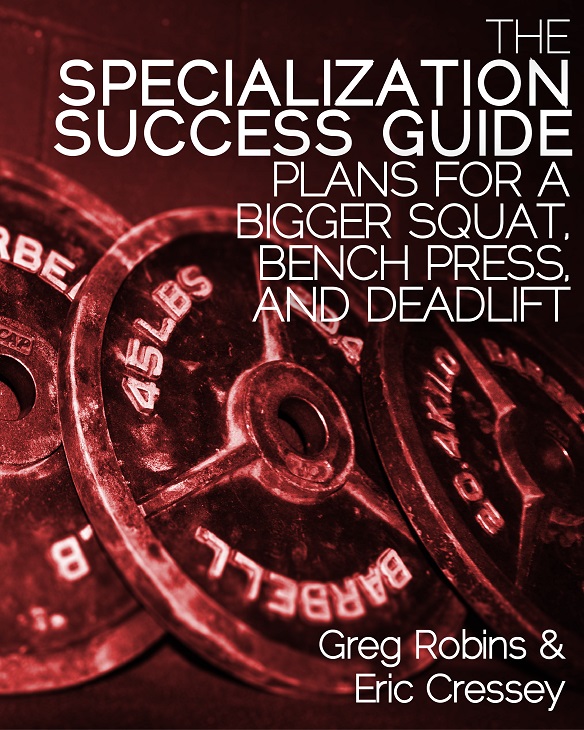
Bench Press Technique: Should You Keep Your Feet Up?
A while back, I published an article, Are Pull-ups THAT Essential?, that was the single most popular in the history of EricCressey.com. One particularly important point I made was that chronically driving the scapulae into depression with overuse of the lats could lead to various injuries in lifters and athletes.
In the comments section after the article, one reader had a great question along these lines: Isn’t benching with a big arch and cueing “down and back” with the shoulder blades during a bench press the exact same thing? Shouldn’t the feet be up on the bench to get people out of extension?
I think it is a similar thing, but not the exact same thing. And, I am not a fan of bench pressing with the feet up on the bench.
Before I get into the details of why, though, we should make an important differentiation between “gym” bench press technique and the bench press technique used by competitive powerlifters in competition.
In competition powerlifting bench press technique, the goal is to shorten the range of motion of the bar while maximizing leg drive. Putting yourself in a big lower back arch and tucking the feet up under you more is the way to do this. Additionally, equipped powerlifters wear bench press shirts that pull the shoulder blades forward, and the humerus into extension past the body. Accordingly, the lifter has to consciously pull the shoulder blades down and back to counteract this tension and not jack up the anterior aspect of the shoulder. After about 20 minutes of searching my laptop, I found this old video of me from 2005 when I was a legit 165-pounder (you can tell by the ostrich legs). Notice the big arch and how much upper back involvement I needed to “fight” the shirt (and, for the record, I was never good at using the shirt…hated those things):
The Average Joe doesn’t need to worry about these factors when he’s lifting in the gym; he just needs to figure out what gives him the optimal set-up to stay healthy and still benefit from the exercise. Still, I think we can learn a few things from the powerlifting approach.
First, I’m not convinced that such substantial loads for the upper body alone are a good thing. There are smaller joint structures and more mobility than stability than we see in the lower body, which can handle far greater loads. Sharing the load with the lower body tends to better distribute overall training stress. Bringing the feet up on the bench takes this away.
Second, folks are more likely to go into excessive humeral extension (elbows pass the body) in the bottom position with a “sunken” chest. So, they either jack up the anterior aspect of the shoulder there – or the elbows flare out and we deal with a host of other stability issues.
Third, in standing, we actually have a “normal” lordotic curve. I think it’s optimal to maintain this lordotic curve on the bench rather than take it away completely. Core stability isn’t about cranking someone into excessive extension or flexion; it’s about learning how to maintain neutral. A “middle of the road” approach like the one in the videos below is fine for most lifters (you’ll notice a slight arch is even more important on the close grip bench press, as there is a greater tendency for humeral extension past neutral when the hands are closer together):
Fourth, there is something to be said about learning from very strong people and their experiences. We learned about how bracing was far superior to hollowing in terms of core stability by simply looking at world class squatters and what they did under insane loads. Along these same lines, you simply don’t see world class bench pressers with the feet up and shoulder blades winging out. The flat back posture shifts guys into an abducted scapulae position from the get-go – and it becomes excessive at the top of the press. Internal rotation with protraction closes down the subacromial space and can cause increased rotator cuff impingement as well. A similar thing actually happens when guys have to lift off the racks to themselves to start the lift, and it’s one reason why I always recommend getting a bench press handoff.
Fifth, you have to appreciate that the amount of time spent in scapular depression and lumbar extension (if you are even past the point of “neutral”) is relatively trivial. If this position provides some extra stability, and doesn’t take place for long enough to yield chronic adaptations, I’m all for it.
Hopefully, this brief overview explains why I don’t like to have the feet up with bench press technique. If you’re looking to learn more, I’d encourage you to check out The Specialization Success Guide, a resource I co-authored with Greg Robins. It features some thorough bench press technique advice, as well as proven bench press specialization strength training programs.



